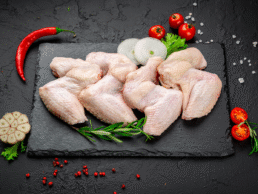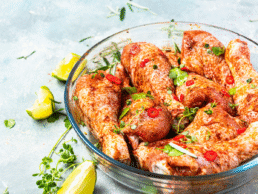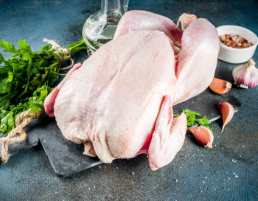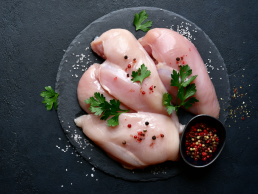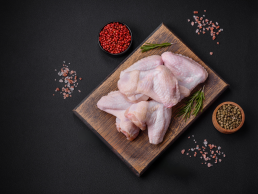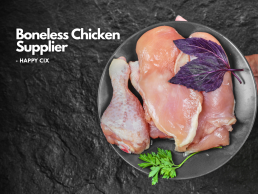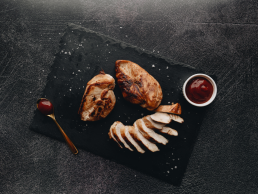Chicken Fillet Marinated Bali: Happy Cix
Chicken Fillet Marinated Bali - The culinary scene in Bali continues to expand as more restaurants, cafés, hotels, and catering services emerge to serve both local residents and millions of international visitors. In this fast-growing market, the need for high-quality, practical, and flavor-consistent food ingredients has become increasingly essential. Among the most in-demand products today is Chicken Fillet Marinated Bali, known in English as Balinese-style marinated chicken fillet. Happy Cix stands out as a trusted provider of premium, professionally marinated chicken fillets that offer convenience, reliability, and superior taste.
This article explores the full advantages of the product, its quality standards, how it supports commercial kitchens, and why Happy Cix has become a preferred supplier in Bali’s competitive foodservice industry.
1. Premium Chicken Fillet with Strict Selection Standards

To deliver exceptional results, Happy Cix begins with high-quality raw materials. Each chicken fillet is carefully selected based on moisture level, texture, thickness, and overall freshness. This ensures that every portion of Chicken Fillet Marinated Bali meets professional culinary expectations.
The fillets are trimmed cleanly and uniformly. This avoids inconsistencies often found in manually processed chicken—such as uneven thickness, excess fat, or loose skin. The meticulous trimming not only enhances presentation but also ensures even cooking and predictable texture.
For restaurants and hospitality businesses, consistency is essential. Happy Cix provides fillets that look the same, cook the same, and taste the same every time, allowing chefs to maintain menu quality with ease.
2. Professional Marination Featuring Balinese Flavor Profile
The marination process is what distinguishes Chicken Fillet Marinated Bali from ordinary chicken fillets. Happy Cix applies a professional marination technique using a balanced blend of fresh spices, aromatic herbs, and signature Balinese flavor elements. Each fillet is coated and rested under controlled conditions to ensure the marinade penetrates deeply into the meat fibers.
Key advantages of Happy Cix’s professional marination include:
- Deep absorption of seasoning
- Natural aroma that enhances cooking results
- Balanced flavor suitable for international and local cuisines
- Consistency across all batches
- No overpowering taste, allowing chefs to customize dishes further
This makes Chicken Fillet Marinated Bali suitable for a wide variety of cooking methods—grilling, roasting, pan-searing, deep-frying, or baking.
3. A Practical and Efficient Solution for Modern Kitchens
Time efficiency is one of the biggest challenges in commercial kitchens, especially in Bali, where customer volume fluctuates dramatically during peak tourism seasons. Preparing chicken fillets manually—cleaning, trimming, seasoning, and marinating—can be time-consuming and resource-intensive.
By using Chicken Fillet Marinated Bali, businesses benefit from:
- Eliminated prep time
- Reduced labor requirements
- Faster order fulfillment
- More consistent menu quality
- Lower risk of cross-contamination
- Minimal kitchen waste
Restaurants, cafés, hotels, and catering services can focus more on cooking and plating rather than lengthy preparation stages. This allows them to keep up with high order volumes while maintaining high standards.
4. Hygienic and Modern Packaging
To preserve freshness and maintain flavor quality, Happy Cix uses modern vacuum or semi-vacuum packaging. This packaging method protects the fillets from air exposure, bacteria growth, and flavor degradation.
The product is maintained within a strict cold-chain system from production to delivery. This ensures every package of Chicken Fillet Marinated Bali arrives in excellent condition—fresh, fragrant, and ready to cook.
For businesses that prioritize hygiene and food safety, this level of control is a major advantage.
5. Suitable for a Wide Range of Menu Concepts
One of the strengths of Chicken Fillet Marinated Bali from Happy Cix is its versatility. Its balanced seasoning allows chefs to easily integrate it into different menu styles without clashing with other ingredients.
Some popular dishes that commonly use marinated chicken fillet include:
- Grilled chicken steak
- Crispy marinated chicken
- Rice bowl chicken menus
- Balinese-style spicy grilled chicken
- Healthy salad chicken protein
- Chicken wraps and sandwiches
- Hotel BBQ and buffet menus
- Fusion Asian–Western dishes
Because the product adapts well to various culinary concepts, it is highly favored by both large-scale hospitality businesses and small F&B entrepreneurs.
6. Supporting Bali’s UMKM and Food Entrepreneurs
Happy Cix aims not only to supply restaurants and hotels but also to empower small culinary businesses across Bali. Many UMKM face difficulties in preparing consistent chicken marinades or maintaining hygiene standards due to limited space and equipment.
Chicken Fillet Marinated Bali solves these challenges by giving UMKM access to:
- Ready-to-use, high-quality chicken
- Stable and reliable flavor
- Efficient production without technical complexity
- Reduced operational cost
- Higher menu value and customer satisfaction
This support helps small businesses compete with larger establishments by offering dishes with professional taste and consistent quality.
7. Commitment to Food Safety and Quality Control
Food safety is a critical priority for Happy Cix. Each stage of the production process is carried out under strict hygiene standards—from poultry selection and filleting to seasoning, packaging, and delivery.
Happy Cix continuously performs:
- Quality checks on raw materials
- Temperature monitoring during processing
- Sanitation procedures for production staff
- Batch-by-batch inspection
- Controlled storage and delivery systems
This ensures that every serving of Chicken Fillet Marinated Bali is not only delicious but also safe and reliable.
8. Why Choose Happy Cix?

Many businesses in Bali choose Happy Cix because of these key strengths:
- Premium chicken fillet quality
- Authentic Balinese marination flavor
- High practicality for busy kitchens
- Hygienic, modern vacuum packaging
- Consistent taste and texture
- Suitable for various menu applications
- Reliable delivery and professional service
With these advantages, Happy Cix has become a trusted and essential partner for many F&B operators seeking stable supply and premium product performance.
Conclusion
In Bali’s competitive culinary market, high-quality food ingredients are crucial to achieving consistent results and customer satisfaction. Chicken Fillet Marinated Bali: Happy Cix offers a complete solution for businesses looking for premium marinated chicken fillets that are flavorful, practical, safe, and versatile.
By combining industry-standard quality control, authentic Balinese flavor, and efficient preparation benefits, Happy Cix provides a product that elevates both the taste and performance of any kitchen. Whether for hotels, restaurants, cafés, catering companies, or UMKM, Chicken Fillet Marinated Bali from Happy Cix is a dependable choice for creating delicious menu experiences with professional consistency.
Marinated Chicken Supplier Bali: Happy Cix
Marinated Chicken Supplier Bali - In today’s rapidly growing culinary industry, speed and consistency of flavor are the two main pillars of success. Not only large restaurants, but also cafés, catering services, and small home-based food businesses now compete to deliver high-quality dishes with maximum efficiency. This is where Happy Cix emerges as the Marinated Chicken Supplier Bali, offering practical, hygienic, and cost-effective solutions for all food entrepreneurs across the Island of the Gods.
With advanced technology and years of experience, Happy Cix pioneers the production of ready-to-cook marinated chicken that is not only delicious but also helps businesses optimize kitchen efficiency, minimize ingredient waste, and control production costs without compromising flavor or quality.
The Advantages of Happy Cix as a Marinated Chicken Supplier Bali

As a trusted Marinated Chicken Supplier Bali, Happy Cix provides a wide range of advantages that make it a preferred choice among culinary businesses. The first strength lies in the careful selection of high-quality chicken. Every chicken is sourced from certified farms that practice hygienic feeding systems and natural feed management. All cutting processes take place in food-grade facilities to maintain product safety and freshness.
Another key advantage is the marination process. Happy Cix uses modern marination technology with controlled pressure, ensuring every piece of chicken absorbs the seasoning evenly down to the fibers. The result is consistent flavor and texture—whether the chicken is fried, roasted, or grilled. For businesses that rely on taste stability, this process guarantees the same delicious flavor every day.
Additionally, Happy Cix uses vacuum-sealed packaging to maintain freshness and extend shelf life without artificial preservatives. This packaging method not only preserves the chicken’s natural taste but also ensures food safety during storage and distribution throughout Bali.
Time Efficiency in Every Kitchen
One of the main reasons culinary businesses choose Happy Cix as their Marinated Chicken Supplier Bali is the time efficiency it provides. In commercial kitchens, time equals profit. Normally, marinating chicken takes hours—preparing ingredients, mixing spices, and waiting for the flavors to fully absorb. With Happy Cix, all those steps are completed during production, allowing chefs to cook instantly.
Kitchen teams can now skip long preparation times and focus directly on cooking. This efficiency helps restaurants with high customer volumes serve dishes faster, reducing waiting times and improving customer satisfaction.
In addition, Happy Cix helps streamline workflow. There is no need to rely on individual skill in balancing spice portions—flavors remain consistent regardless of who is cooking. This gives peace of mind to business owners and ensures every serving meets the same quality standard.
Ingredient and Cost Efficiency That Makes a Difference
Efficiency is not just about time—it’s also about resources and cost. Happy Cix understands how challenging it is to control food expenses in a restaurant environment. By sourcing from a Marinated Chicken Supplier Bali like Happy Cix, businesses save money on bulk spices and reduce ingredient waste.
Each product comes with a precise seasoning ratio, eliminating the need for manual mixing or costly trial-and-error recipes. The result is predictable, stable ingredient costs and consistent flavors across every batch.
The ready-to-cook vacuum-packed format also saves kitchen space. You no longer need to store piles of raw spices or fresh herbs separately. Every pack is portioned for immediate use, minimizing mess and ensuring optimal hygiene.
These efficiencies translate into tangible cost savings. Restaurants can reallocate their budget toward new menu development, marketing, or interior upgrades—all while maintaining their high standards of flavor and presentation.
Custom Seasoning: Tailored Flavor for Every Business

Every culinary business has its own flavor identity. Some prefer bold and spicy Indonesian profiles, while others seek sweet and savory Western-style marinades. Happy Cix recognizes these unique needs and offers a custom seasoning service that allows clients to create their own distinctive taste.
Through this service, customers can adjust spice intensity, sweetness, aroma, and overall taste balance to match their restaurant’s concept. Supported by an experienced R&D team, Happy Cix as Marinated Chicken Supplier Bali develops signature marinades that enhance each brand’s individuality while maintaining consistent quality.
For example, Western-style restaurants may request barbeque or black pepper marinades, while local eateries can opt for flavors like Balinese betutu, rica-rica, or honey chili. This flexibility empowers chefs to innovate without worrying about production complexity.
Moreover, custom seasoning helps businesses maintain their secret recipes efficiently. Rather than blending spices daily, restaurants can order ready-to-cook chicken with their private formula directly from Happy Cix—ensuring secrecy, consistency, and convenience all at once.
Guaranteed Quality and Cold Chain Distribution
Beyond flavor and efficiency, Happy Cix is also committed to maintaining product quality from factory to kitchen. Every batch of marinated chicken is delivered through a cold chain system, ensuring consistent temperature and freshness throughout transportation.
All products undergo strict quality control checks, including packaging inspection, temperature monitoring, and sensory evaluation. This ensures that customers always receive marinated chicken that meets professional food safety and taste standards.
Happy Cix caters not only to large restaurants but also to small and medium enterprises. From home-based kitchens to catering companies and food trucks, everyone can order based on their needs without minimum bulk requirements.
With a strong distribution network across Bali, deliveries are fast, reliable, and temperature-controlled. This consistency makes Happy Cix the go-to choice for businesses seeking a dependable Marinated Chicken Supplier Bali.
Why Happy Cix Is the Right Partner for Your Business
Choosing the right marinated chicken supplier goes beyond pricing—it’s about trust, consistency, and value. Happy Cix embodies all these aspects. With its modern production standards, efficient workflow, and dedication to quality, it ensures every marinated chicken product is tender, flavorful, and ready to cook at any time.
By combining time-saving preparation, controlled cost management, and customizable seasoning options, Happy Cix is not just a supplier—it’s a reliable partner that helps culinary businesses grow faster and operate more efficiently in Bali’s competitive food scene.
For those who value flavor consistency, hygiene, and operational simplicity, Happy Cix stands as the ideal Marinated Chicken Supplier Bali.
Discover more about its products and ordering options at trusted marinated chicken supplier in Bali.
Happy Cix: Kuta Chicken Supplier
Kuta Chicken Supplier - In Bali’s thriving culinary scene, especially in the vibrant area of Kuta, the quality of ingredients defines the identity and reputation of every food business. Among the most essential ingredients in the hospitality and restaurant industry is chicken a staple protein that demands both freshness and safety. As demand continues to grow for high-quality and reliable poultry, Happy Cix stands out as a trusted Kuta Chicken Supplier, offering excellence, consistency, and professionalism to meet the needs of Bali’s top restaurants, hotels, and cafes.
Commitment to Premium Quality
 As a leading Kuta Chicken Supplier, Happy Cix prioritizes quality at every stage from selecting healthy chicks, maintaining hygienic farms, to handling, slaughtering, and packaging the products. Each chicken supplied by Happy Cix is guaranteed fresh, chemical-free, and tender in texture, ensuring that every chef and restaurant owner receives only the best ingredients.
As a leading Kuta Chicken Supplier, Happy Cix prioritizes quality at every stage from selecting healthy chicks, maintaining hygienic farms, to handling, slaughtering, and packaging the products. Each chicken supplied by Happy Cix is guaranteed fresh, chemical-free, and tender in texture, ensuring that every chef and restaurant owner receives only the best ingredients.
Happy Cix implements a modern cold-chain distribution system to maintain freshness from farm to kitchen. Chickens are delivered using refrigerated vehicles, preserving optimal temperature conditions throughout the journey. This meticulous process ensures that every product arrives in perfect condition one of the key reasons why many culinary professionals in Kuta consistently rely on Kuta Chicken Supplier from Happy Cix.
Strict Food Safety and Hygiene Standards
In the food business, safety and cleanliness are non-negotiable. Happy Cix, as a reputable Kuta Chicken Supplier, understands that Kuta’s hospitality industry demands only the safest and most hygienic poultry. That’s why all production processes are supervised by trained professionals under strict sanitation protocols.
All chickens are processed in facilities that meet modern food safety standards. Equipment made of stainless steel ensures a sterile environment, and packaging uses eco-friendly, food-grade materials that keep the chicken fresh while being safe for consumers. This dedication to hygiene and quality gives every Happy Cix client full confidence in their supply chain from production to plating.
Fast and Reliable Delivery Services
In the competitive culinary market of Bali, timing is everything. Recognizing this, Happy Cix has built a highly responsive logistics system that ensures every order arrives fresh and on schedule. Whether it’s a small café, a busy restaurant, or a five-star hotel, Happy Cix provides customized delivery schedules that align with each client’s operational rhythm.
As a professional Kuta Chicken Supplier Happy Cix values punctuality and consistency. Clients can count on daily or weekly deliveries, flexible ordering options, and responsive customer support. This reliable service has positioned Happy Cix as one of the most dependable poultry suppliers in the region a true partner for any business that values quality and efficiency.
Building Long-Term Business Partnerships
Happy Cix goes beyond being just a Kuta Chicken Supplier it’s a partner in success. The company believes in building lasting relationships with its clients through transparency, communication, and commitment. Every feedback is taken seriously, helping the company continuously improve its products and services.
For Happy Cix, trust is everything. The brand ensures full transparency in its supply process, allowing clients to understand the origin of their chicken, how it’s processed, and how quality is maintained. This open approach fosters mutual respect and confidence, strengthening its reputation as a Kuta Chicken Supplier that truly values its partners.
Comprehensive Product Range
Happy Cix offers a wide range of chicken products to cater to diverse culinary needs. The selection includes whole chickens, chicken cuts, boneless fillets, and ready-to-cook items. Each product meets the standards of professional kitchens, guaranteeing consistent quality and taste.
This product diversity makes Happy Cix a one-stop solution for Bali’s culinary industry. Whether you run a traditional Indonesian restaurant, a modern café, or an international hotel kitchen, Happy Cix has the right type of chicken for your recipes. By working with a reliable Kuta Chicken Supplier, businesses gain access to high-quality poultry that enhances both menu performance and customer satisfaction.
Sustainability and Environmental Responsibility
In today’s world, sustainability matters more than ever. Happy Cix takes active steps toward environmentally responsible practices throughout its production and distribution systems. As a responsible Kuta Chicken Supplier, the company applies green business principles such as energy efficiency, waste management, and eco-conscious packaging.
Beyond environmental responsibility, Happy Cix also collaborates with local Balinese farmers, empowering them to improve their poultry farming standards and livelihood. This partnership not only ensures stable chicken supply but also contributes to the growth of the local economy a reflection of the brand’s deep-rooted commitment to sustainability and community development.
Competitive and Transparent Pricing
Cost-effectiveness is vital in maintaining a successful culinary operation. Understanding this, Happy Cix provides transparent and competitive pricing structures for every client. The company believes that premium quality doesn’t always have to come with a high price tag. Instead, Happy Cix focuses on delivering value combining top-tier quality with fair pricing.
Clients can also request custom supply plans to match their specific operational needs. Whether you’re managing daily restaurant operations or seasonal events, Happy Cix offers flexible solutions that optimize your budget without compromising product standards. This approach strengthens its position as a customer-oriented Kuta Chicken Supplier trusted by many in Bali’s food industry.
Why Choose Happy Cix as Your Kuta Chicken Supplier
 Among the many poultry suppliers in Bali, Happy Cix stands out for its consistency, professionalism, and reliability. The brand’s dedication to product quality, on-time delivery, and long-term partnerships makes it the preferred Kuta Chicken Supplier for many leading restaurants and hotels.
Among the many poultry suppliers in Bali, Happy Cix stands out for its consistency, professionalism, and reliability. The brand’s dedication to product quality, on-time delivery, and long-term partnerships makes it the preferred Kuta Chicken Supplier for many leading restaurants and hotels.
Happy Cix doesn’t just supply chicken it provides confidence. Each delivery carries the assurance of freshness, hygiene, and top-quality service. The company’s reputation continues to grow across Bali as more culinary businesses recognize the benefits of working with a partner who understands their operational challenges and goals.
Conclusion
Kuta’s culinary landscape is dynamic, fast-paced, and demanding. In such an environment, the right supply partner can make all the difference. Happy Cix, as a trusted Kuta Chicken Supplier offers more than just poultry it delivers quality, safety, and partnership built on integrity.
With a strong commitment to hygiene, sustainability, and service excellence, Happy Cix has become the go-to choice for businesses seeking a reliable chicken supplier in Bali. Whether you run a beachfront café, a luxury resort, or a bustling eatery in Kuta, Happy Cix ensures your kitchen never runs out of fresh, safe, and high-quality chicken.
When excellence matters, trust Happy Cix the professional Kuta Chicken Supplier dedicated to supporting Bali’s world-class culinary industry with reliability, quality, and heart.
Bali Marinated Chicken: Happy Cix
Bali Marinated Chicken - Bali has always been a land of inspiration — where natural beauty, rich traditions, and culinary artistry blend seamlessly. Among the island’s many culinary gems, Bali Marinated Chicken has become one of the most beloved dishes, symbolizing the perfect harmony between spice, texture, and culture. More than just a meal, it represents the true essence of Balinese flavor — warm, aromatic, and soulful.
The Art of Perfect Marination
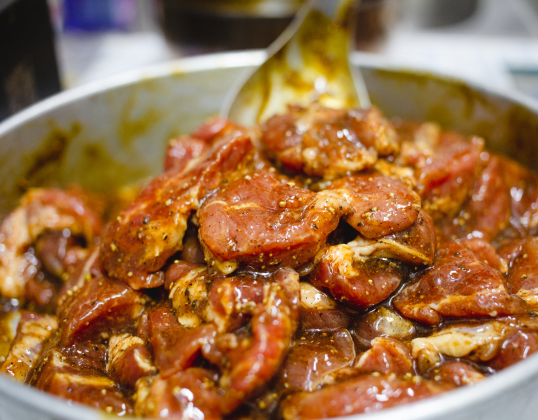
The secret behind the irresistible taste of Bali Marinated Chicken lies in the marination process itself. Fresh chicken is soaked for hours in a mixture of local herbs and spices — garlic, shallots, ginger, lemongrass, coriander, and a hint of turmeric. These natural ingredients not only enhance the aroma but also tenderize the meat, allowing every bite to carry layers of flavor.
Traditional Balinese cooking often involves patience and balance. The marination process may take anywhere from four to twelve hours to ensure the seasoning penetrates deep into the meat. Once ready, the chicken is typically grilled or roasted over charcoal to achieve that signature smokey aroma and golden crisp skin. The result is a dish that is tender inside, flavorful throughout, and irresistibly fragrant — a hallmark of true Bali Marinated Chicken.
A Symphony of Local Spices
What makes Bali Marinated Chicken truly special is its rich combination of tropical spices. Each ingredient serves a purpose. Turmeric adds color and earthy warmth, while lemongrass and kaffir lime leaves give a refreshing citrus note. A touch of palm sugar balances the spiciness from red chili, creating that perfect blend of sweet, savory, and slightly tangy taste that defines Balinese cuisine.
The flavor profile is bold yet balanced — no single spice overpowers another. Every element works in harmony, just like the philosophy of Bali itself, where life revolves around balance and gratitude. With every bite, you can sense the island’s vibrant spirit and the deep respect Balinese people have for nature and food.
The Cultural Meaning Behind the Dish
Food in Bali is never just food — it’s a story. For the Balinese, cooking is an act of devotion, a way to express harmony between humans, nature, and spirituality. That philosophy extends to Bali Marinated Chicken, which reflects care, patience, and respect for ingredients.
In many Balinese households, marination is treated as an art form. The process begins early in the morning, accompanied by the rhythmic sounds of grinding spices with traditional stone mortars. The slow pace, the natural aroma, and the attention to detail turn the cooking process into a form of meditation — one that connects the cook to the island’s deep-rooted culture.
A Dish for Every Occasion
Whether served during a temple ceremony, a family celebration, or a quiet evening dinner, Bali Marinated Chicken fits every moment perfectly. Its versatility allows it to pair beautifully with steamed rice, sambal matah, and fresh vegetables. The balance of flavors ensures it’s not too spicy for those unfamiliar with local dishes, yet flavorful enough to satisfy spice lovers.
Restaurants and local eateries across Bali have embraced this dish as a signature menu item. Some preserve the traditional recipe, while others experiment with modern touches such as honey glaze or barbecue-style marinades. Despite these variations, the soul of Bali Marinated Chicken remains unchanged — a deep connection to Balinese identity through flavor and fragrance.
A Favorite Among Travelers
For visitors, discovering Bali Marinated Chicken often becomes one of their most memorable culinary experiences on the island. The combination of tender chicken and aromatic spices offers something comforting yet exotic. Many tourists even try to recreate the recipe when they return home, seeking to relive the authentic taste of Bali in their kitchens.
Some local culinary schools and restaurants have started offering cooking classes that teach how to prepare Bali Marinated Chicken from scratch. Through these experiences, travelers not only learn a recipe but also gain insight into Balinese culture, traditions, and values surrounding food and community.
Innovation Meets Tradition
As the culinary landscape evolves, Bali Marinated Chicken continues to adapt without losing its authenticity. Many local businesses have introduced ready-to-cook or frozen versions, allowing people to enjoy the taste of Bali wherever they are. With vacuum-sealed packaging and preserved freshness, the dish maintains its distinct aroma and flavor even after weeks of storage.
This innovation caters to modern lifestyles — practical, clean, and consistent — while keeping the roots of Balinese taste alive. Thanks to this balance between tradition and technology, Bali Marinated Chicken is now enjoyed far beyond the island, gaining recognition across Indonesia and even overseas.
Happy Cix: Where Authentic Taste Meets Modern Craft
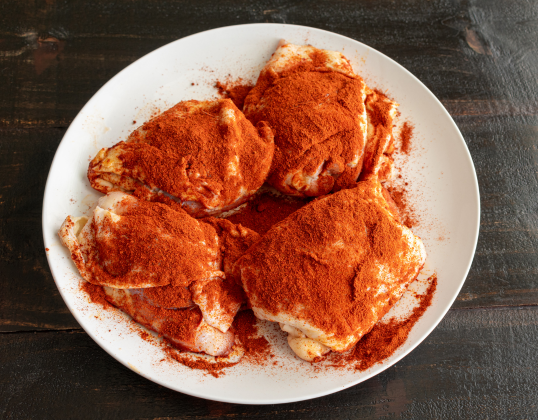
In this evolving culinary scene, Happy Cix stands out as a brand that successfully bridges tradition with innovation. With a deep appreciation for Bali Chicken Supplier, Happy Cix has perfected the art of Bali Marinated Chicken using high-quality local ingredients and precise marination techniques.
Each piece of chicken goes through a careful selection process, ensuring freshness and tenderness. The brand uses all-natural spices sourced from trusted local farmers and avoids artificial preservatives, maintaining a genuine homemade flavor. Through a combination of traditional recipes and modern food technology, Happy Cix manages to deliver consistency, hygiene, and authenticity in every product.
Happy Cix believes that great food should not only taste delicious but also tell a story. Their Bali Marinated Chicken embodies this philosophy — a flavorful journey that connects diners to the warmth of Balinese hospitality and the island’s deep-rooted culinary heritage.
The Future of Balinese Culinary Heritage
The rise of Bali Marinated Chicken in modern kitchens reflects how traditional food can stay relevant in today’s fast-paced world. As more people seek natural and authentic flavors, dishes like this become ambassadors of culture — preserving local wisdom while appealing to global palates.
With brands like Happy Cix leading the way, the future of Balinese cuisine looks bright. By respecting the past and embracing the present, they ensure that authentic flavors will continue to inspire both locals and travelers.
Conclusion
Bali Marinated Chicken is more than just a recipe — it is a celebration of Bali’s culture, spirit, and passion for flavor. From its deep marination to its fragrant blend of spices, every detail reflects the island’s artistry and devotion to balance.
Through Happy Cix, this traditional taste has found new life in the modern culinary world. It’s clean, authentic, and crafted with love — allowing anyone, anywhere, to experience the true soul of Balinese cuisine.
For those who crave a dish that speaks of warmth, authenticity, and heritage, Bali Marinated Chicken from Happy Cix is more than food — it’s the essence of Bali served on a plate.
Halal and Hygienic Slaughtered Chicken Supplier in Indonesia
Slaughtered Chicken Supplier - Freshly slaughtered chicken is one of the most essential food ingredients in the daily lives of Indonesian people. Almost every traditional dish, from satay, opor, fried chicken, to soup, uses chicken meat as the main ingredient. Not only because of its delicious taste and versatility, chicken also has high nutritional value, is rich in protein, and is generally more affordable compared to beef or certain types of fish. Due to the enormous market demand, the existence of a Slaughtered Chicken Supplier plays a crucial role in ensuring the availability of fresh chicken that is halal, hygienic, and meets health standards.
However, not all suppliers are able to provide the best quality. In the food industry, especially when it comes to fresh meat, consumers pay close attention to aspects such as hygiene, meat quality, and halal assurance. Therefore, choosing the right supplier becomes an important decision, both for culinary business owners and households that prioritize health and food quality.
The Importance of Choosing a Reliable Slaughtered Chicken Supplier
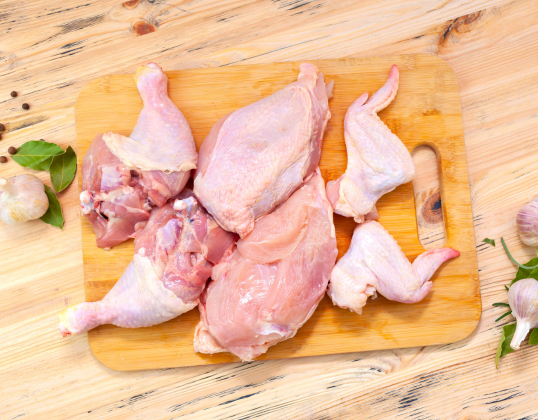
As public awareness of healthy lifestyles increases, the demand for hygienically processed chicken has also grown. Consumers today are not only looking for chicken at affordable prices, but they are also concerned about the origin of the product, slaughtering methods, storage, and distribution processes. In this regard, a Slaughtered Chicken Supplier that implements hygienic management, ensures a safe supply chain, and complies with halal standards will always be the preferred choice.
A trustworthy supplier will ensure that the chickens are slaughtered according to Islamic law, then processed using strict cleanliness standards. This process includes cleaning, cutting, and packaging in proper conditions to keep the meat fresh for longer. In addition, proper cold storage is essential to prevent bacterial contamination that could endanger consumers’ health.
Quality Standards in the Poultry Industry
The poultry industry in Indonesia continues to grow rapidly along with increasing market demand. The government and relevant institutions have established several regulations and food safety standards that every Slaughter Chicken Supplier must comply with. Some key quality benchmarks include:
- Halal Certification
Chicken products must go through slaughtering procedures that follow Islamic law, supervised by competent personnel, and certified halal by official institutions. This ensures consumer confidence, especially in Indonesia’s Muslim-majority population. - Hygienic Production Process
Every stage—from slaughtering, cleaning, packaging, to distribution—must comply with hygiene standards. Professional suppliers usually adopt HACCP (Hazard Analysis Critical Control Point) or GMP (Good Manufacturing Practice) systems. - Meat Quality
Good chicken meat has a firm texture, bright color, no foul odor, and is free from harmful additives. Experienced suppliers are able to maintain these qualities from the slaughterhouse to the customer’s hands. - Distribution System
Distribution speed determines product freshness. Suppliers with sufficient logistics networks can ensure that the chicken remains fresh even when transported over long distances.
The Role of Slaughtered Chicken Suppliers in the Culinary Industry
Indonesia’s culinary industry is thriving, ranging from small-scale food stalls to five-star hotel restaurants. Every business requires a steady supply of fresh chicken in large quantities. This is where the role of a Slaughtered Chicken Supplier becomes indispensable.
A reliable supplier can fulfill demand consistently, stabilize pricing, and guarantee high-quality chicken. This directly impacts the sustainability of culinary businesses, as the quality of raw materials determines taste and customer satisfaction. For business owners, building a long-term partnership with a trusted supplier is an important investment in maintaining business continuity.
Challenges Faced by Slaughtered Chicken Suppliers
Despite the large market opportunities, the chicken supply industry in Indonesia faces several challenges. Some of these include:
- Feed Price Fluctuations: The cost of chicken feed greatly affects production expenses, requiring suppliers to balance pricing while staying competitive.
- Poultry Health: Diseases among poultry can significantly impact supply. Professional suppliers usually implement strict biosecurity systems to prevent disease outbreaks.
- Cold Chain Limitations: Not all regions have sufficient cold storage facilities, making fresh chicken distribution to remote areas more challenging.
- Market Competition: With many suppliers in the market, companies must consistently maintain product quality and services to earn consumer trust.
Criteria of an Ideal Slaughtered Chicken Supplier
For both consumers and businesses, choosing a chicken supplier should not be done carelessly. Some criteria to consider include:
- Business Legality – Official suppliers are registered and have operational permits from relevant authorities.
- Halal and Hygiene Certification – This is a primary indicator that the product meets required standards.
- Consistent Supply and Quality – Good suppliers can deliver uniform quality with stable availability.
- Competitive Pricing – While quality is the top priority, fair pricing remains important for businesses.
- Customer Service and Responsiveness – An ideal supplier has a responsive customer support team ready to address needs and concerns.
Trends in Chicken Meat Demand in Indonesia
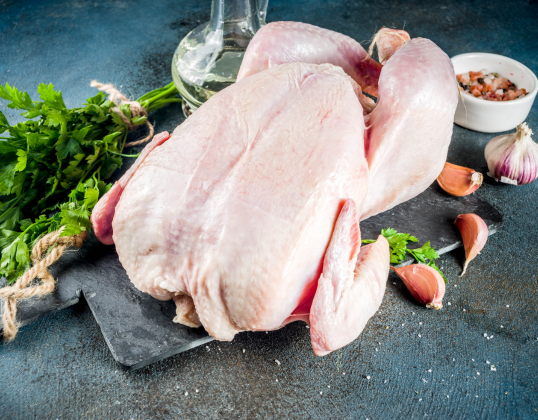
With its large population and diverse culinary culture, Indonesia’s demand for chicken meat is expected to continue rising. The fast-paced lifestyle of urban communities also drives demand for ready-to-cook chicken products that are hygienically packaged and accessible through online platforms. Many Slaughtered Chicken Suppliers are now integrating digital technology into their services, such as ordering via apps or marketplaces, allowing consumers to purchase fresh chicken without having to visit traditional markets.
Recommended Chicken Supplier in Bali
For both the public and culinary business players in Bali, choosing a high-quality chicken supplier is certainly a priority. One of the most recognized brands that has consistently provided halal, fresh, and hygienic slaughtered chicken is Happy Cix.
Happy Cix focuses not only on product quality but also on professional and efficient services. With slaughtering procedures that follow Islamic law and a well-maintained distribution system, Happy Cix has earned the trust of restaurants, hotels, and households across Bali. Their strength lies in their commitment to hygiene, from slaughtering and storage to final delivery.
Moreover, Happy Cix emphasizes transparency in every process. Consumers can immediately notice the freshness of the chicken—firm texture, natural taste, and free from additives. It is no surprise that the brand has become increasingly popular as the best Chicken Supplier in Bali, making it the right choice for those who prioritize health, convenience, and satisfaction.
Reasons to Choose Happy Cix's Bali Chicken Breast Fillet
Bali Chicken Breast Fillet - Chicken meat is one of the most consumed sources of animal protein in Indonesia. Besides being relatively affordable, chicken is also easy to process into a variety of daily dishes, from traditional to modern cuisine. Among the many chicken parts, the breast is one of the most popular, especially in fillet form. In Bali, the demand for Chicken Breast Fillet continues to rise along with the growth of healthy lifestyles, culinary trends, and the needs of the culinary and tourism industry on the island.
The Popularity of Chicken Breast Fillet in Bali
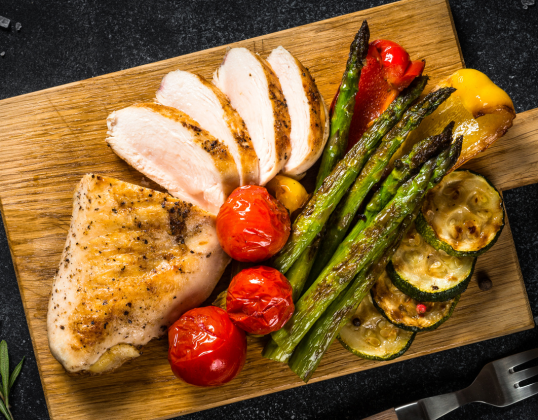
As an international tourist destination, Bali not only offers natural beauty and culture but is also renowned as a culinary haven. Many restaurants, cafés, and hotels use chicken breast fillet as a main ingredient in their menus. Boneless and skinless chicken breast cuts are highly practical for cooking, whether for grilled dishes, steaks, or Asian specialties.
For locals, Bali Chicken Breast Fillet is also a practical choice for household needs. In addition to being quick to cook, chicken breast has a tender texture and lower fat content, making it ideal for healthy eating. No wonder this product is increasingly available in modern markets, supermarkets, and trusted meat suppliers.
Advantages of Chicken Breast Fillet Compared to Other Parts
Compared to other chicken parts, the breast offers several advantages that make it more popular. First, chicken breast is a high-quality protein source with lower fat content than thighs. This makes it the top choice for people on low-fat diets or those building muscle mass.
Second, the versatile texture of chicken breast makes it easy to combine with different seasonings and cooking methods. From traditional dishes such as chicken soup or spicy chicken, to international favorites like chicken katsu or grilled chicken breast, all can be prepared deliciously using breast fillet.
Third, in fillet form, chicken breast is more practical since it is already separated from the bone. Consumers don’t need to spend time cutting or cleaning, saving time in meal preparation.
Consumption Trends of Chicken Breast Fillet in Bali
As a world-class tourism hub, Bali requires a large supply of chicken meat. Hotels, restaurants, beach clubs, and wedding catering services all need high-quality chicken breast every day. Bali Chicken Breast Fillet is one of the most sought-after products because it meets practical, hygienic, and consistent flavor standards.
Additionally, the healthy lifestyle trend is also rising among Balinese residents. Many are switching to high-protein and low-fat diets. Chicken breast fillet has become a favorite among fitness communities, healthy dieters, and meal prep enthusiasts.
Challenges in Choosing Chicken Breast Fillet in Bali
Although easy to find, not all chicken breast fillet in Bali offers the same quality. The main challenges lie in hygiene, freshness, and processing methods. Poorly handled products can affect taste, texture, and even food safety.
Moreover, with the high demand from the culinary sector, many businesses require suppliers capable of delivering large quantities of chicken breast fillet with consistent quality. Therefore, choosing a reliable provider is crucial for both individuals and businesses.
Reasons to Choose Bali Chicken Breast Fillet from Happy Cix
Amid the many options available, Happy Cix stands out as a trusted brand delivering high-quality chicken breast fillet in Bali. As the Best Chicken Slaughterhouse in Bali, Happy Cix focuses not only on quantity but also on quality and consumer trust. Here are several reasons why Happy Cix’s chicken breast fillet is the best choice.
1. Hygienic Chicken Processing
Happy Cix applies modern chicken processing standards that prioritize cleanliness and food safety. Every stage is carried out hygienically, ensuring consumers don’t have to worry about contamination or declining product quality.
2. Premium Quality with Fresh Texture
The Bali chicken breast fillet produced by Happy Cix is fresh, tender, and free from unpleasant odors. This makes it ideal for various dishes without compromising taste.
3. Consistency for Business Needs
For restaurants, hotels, and large catering services, consistent quality is key. Happy Cix is able to supply large volumes of chicken breast fillet with stable standards, helping culinary businesses maintain flavor and service excellence.
4. Practical and Ready to Cook
Bali Chicken Breast Fillet from Happy Cix is neatly packaged, boneless, and ready to use. This makes it convenient for both households and professional kitchens to cook without additional preparation.
5. Competitive Price with Guaranteed Quality
Despite offering premium quality, Happy Cix keeps its products competitively priced. This is an added value, especially for businesses requiring regular bulk supply.
Bali Chicken Breast Fillet: A Healthy and Delicious Solution
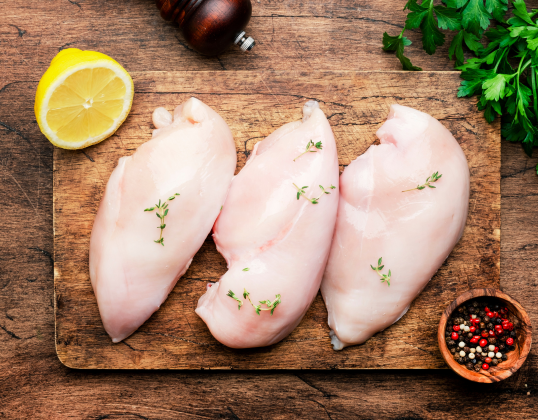
Bali chicken breast fillet is not just another ingredient—it is a practical solution for a healthy lifestyle. With its high protein content, low fat, and flexibility for various recipes, this product is a favorite not only for households but also for the culinary industry.
In Bali, where culinary standards are high due to international tourists, the quality of chicken breast fillet is essential. Happy Cix understands this demand and answers it with products that are fresh, hygienic, and consistently excellent.
Recommendation: Happy Cix as the Right Choice
If you are looking for the best Bali Chicken Breast Fillet, Happy Cix is the top recommendation. With its reputation as the Best Chicken Slaughterhouse in Bali, Happy Cix has proven its commitment to delivering trustworthy, high-quality products.
Whether for household use, restaurants, or five-star hotels, Happy Cix’s chicken breast fillet is always a safe, practical, and delicious choice. It not only meets local consumer needs but also the international standards crucial to Bali’s culinary industry.
By choosing Happy Cix, you get more than just premium chicken breast fillet—you support a local brand that values hygiene, innovation, and customer trust. For those who prioritize taste, health, and quality, the answer is clear: Bali Chicken Breast Fillet from Happy Cix is the best choice.
N0.1 Bali Chicken Supplier: Happy Cix
Bali Chicken Supplier - In Bali, the demand for fresh chicken products continues to rise along with the growth of restaurants, hotels, catering services, and bustling traditional markets. The Island of the Gods is not only a world-class tourist destination but also a culinary hub that relies heavily on chicken-based dishes. This growing demand highlights the importance of having a reliable Chicken Supplier in Bali capable of delivering high-quality, hygienic, and consistent products in large volumes. A professional supplier is crucial, as Bali’s culinary and hospitality industries require a stable supply of fresh chicken every single day.
The Importance of Chicken Suppliers in Bali
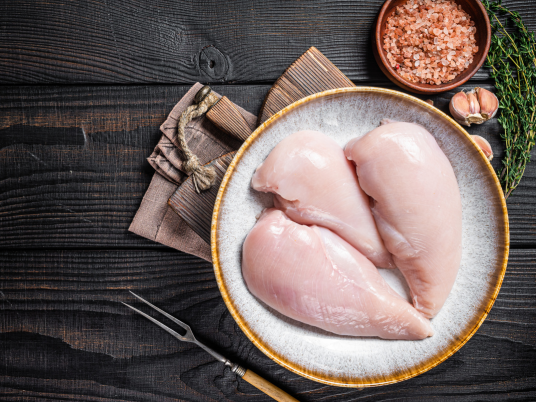 When it comes to the food industry, particularly in Bali, the availability of raw ingredients plays a vital role in business continuity. From five-star hotels and international restaurants to local eateries, all rely on chicken meat that meets strict quality standards. A chicken supplier in Bali is not just a vendor but also a key partner in ensuring that every cut of chicken delivered complies with hygiene and food safety requirements. Suppliers act as the bridge between poultry farms, processing facilities, and end consumers. Without an efficient distribution system, culinary businesses in Bali would struggle to maintain their food quality. This is especially critical since international visitors are highly sensitive to food hygiene and taste, making the role of a trusted chicken supplier even more essential.
When it comes to the food industry, particularly in Bali, the availability of raw ingredients plays a vital role in business continuity. From five-star hotels and international restaurants to local eateries, all rely on chicken meat that meets strict quality standards. A chicken supplier in Bali is not just a vendor but also a key partner in ensuring that every cut of chicken delivered complies with hygiene and food safety requirements. Suppliers act as the bridge between poultry farms, processing facilities, and end consumers. Without an efficient distribution system, culinary businesses in Bali would struggle to maintain their food quality. This is especially critical since international visitors are highly sensitive to food hygiene and taste, making the role of a trusted chicken supplier even more essential.
Bali Chicken Distribution Chains
The distribution chain of Balinese chicken is a complex and well-coordinated system, starting from local farmers who raise chickens with careful attention to feed quality and animal health. This initial stage is crucial because it determines the quality of the chicken meat that will enter the market. Once the harvest period arrives, the chickens are sorted based on size, weight, and physical condition to ensure that only the best products proceed to the next stage of distribution. Distribution coverage includes: Denpasar, Kuta, Gianyar, Badung, and areas outside Bali.
Next, the harvested chickens are sent to collectors or distribution centers responsible for managing the packaging and preservation processes to keep the products fresh until they reach consumers. At this stage, temperature control and hygiene are closely monitored to maintain food safety standards. The distribution then continues through various marketing channels, such as traditional markets, supermarkets, restaurants, and hotels across Bali that require a steady supply of fresh chicken every day.
In this entire distribution chain, the role of suppliers is highly vital. Suppliers not only ensure a stable supply of chicken but also guarantee quality and on-time delivery. One of the leading examples is Happy Cix, recognized as the Number 1 Chicken Supplier in Bali. With its extensive distribution network, modern logistics system, and commitment to premium quality, Happy Cix plays a major role in maintaining a smooth supply of fresh chicken for various culinary sectors throughout Bali.
Challenges in Choosing a Bali Chicken Supplier
While there are many Bali chicken supplier, not all are able to meet industry expectations. Business owners often face several challenges, such as:
- Inconsistent Product Quality Some suppliers fail to maintain proper slaughtering or storage standards, resulting in poor-quality meat upon delivery.
- Late Deliveries Timely delivery is crucial in the food business. Delays can disrupt operations and cause financial losses.
- Lack of Transparency Not all suppliers are open about the origins of their products, which can be a concern for professional businesses.
- Hygiene Standards From slaughtering to packaging, cleanliness must be prioritized. Any negligence in this area puts consumer health at risk.
For this reason, choosing a reliable Bali chicken supplier requires careful consideration. Businesses need a partner with proven consistency and professionalism.
Happy Cix: The Number 1 Bali Chicken Supplier
Among the many suppliers available, Happy Cix has earned a reputation as the most trusted Bali Chicken Supplier. Over the years, Happy Cix has built strong relationships with restaurants, hotels, catering services, and even households across Bali by prioritizing product quality and customer service.
Guaranteed Product Quality
Happy Cix is committed to providing only the freshest and finest chicken products. Every chicken is processed under strict hygiene and food safety standards, ensuring the meat remains fresh, clean, and suitable for professional culinary use.
Wide Range of Products
From whole chickens to specific cuts like fillets, thighs, drumsticks, wings, and even frozen options, Happy Cix offers a complete selection to cater to diverse culinary needs. This variety gives customers the convenience of sourcing everything from a single supplier.
On-Time Delivery
One of Happy Cix’s strongest advantages is its organized distribution system. Orders are delivered on schedule, ensuring that businesses can continue operations without interruption.
Professional Customer Service
Happy Cix values communication and is always ready to provide detailed product information, pricing options, and tailored recommendations. The responsive and friendly team makes working with Happy Cix a smooth experience.
Why Choose Happy Cix?
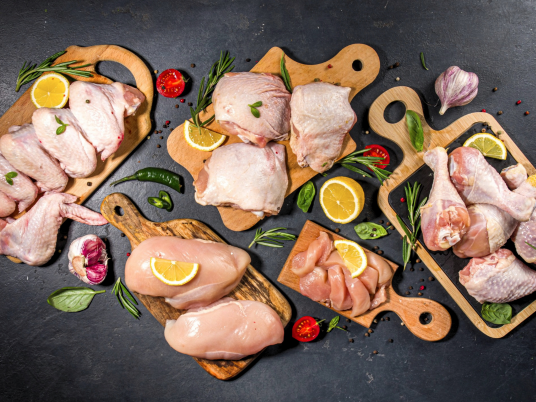 Happy Cix deserves to be called the No. 1 Bali Chicken Supplier because it has a number of consistent advantages in meeting market needs. In terms of quality, Happy Cix always maintains the freshness of its chicken products and ensures high hygienic standards, making them safe and reliable for consumption. It is no wonder that various business sectors in Bali have placed their trust in the services provided. Additionally, Happy Cix offers a comprehensive range of products, including whole chickens and cuts tailored to customer requests, making it flexible for various needs. Timely delivery support further strengthens its reputation, as organized distribution helps ensure the smooth operation of culinary partners' businesses. Moreover, Happy Cix maintains competitive pricing without compromising quality, making it the top choice for culinary businesses in Bali.
Happy Cix deserves to be called the No. 1 Bali Chicken Supplier because it has a number of consistent advantages in meeting market needs. In terms of quality, Happy Cix always maintains the freshness of its chicken products and ensures high hygienic standards, making them safe and reliable for consumption. It is no wonder that various business sectors in Bali have placed their trust in the services provided. Additionally, Happy Cix offers a comprehensive range of products, including whole chickens and cuts tailored to customer requests, making it flexible for various needs. Timely delivery support further strengthens its reputation, as organized distribution helps ensure the smooth operation of culinary partners' businesses. Moreover, Happy Cix maintains competitive pricing without compromising quality, making it the top choice for culinary businesses in Bali.
Conclusion: Your Trusted Bali Chicken Supplier
Bali’s culinary and hospitality industries rely heavily on premium chicken products. The presence of a professional supplier is not just about ensuring business continuity but also about guaranteeing customer satisfaction. Among the many choices available, Happy Cix has proven itself to be a trusted name, offering consistent quality, excellent service, and reliable distribution. For anyone looking for a dependable Bali Chicken Supplier, Happy Cix is the ideal choice. With a strong commitment to delivering only the best, Happy Cix truly deserves its reputation as Bali’s number one chicken supplier, supporting both culinary businesses and household needs across the island.
Boneless Chicken Supplier by Happy Cix
Boneless Chicken Supplier - In today’s modern culinary industry, the demand for high-quality raw ingredients is a top priority. One of the most sought-after products is chicken, particularly boneless chicken. The presence of a reliable Boneless Chicken Supplier plays a vital role for restaurants, hotels, catering services, and small-scale food businesses. With a consistent supply of fresh and hygienic chicken, culinary businesses can maintain both flavor quality and customer trust.
The Importance of Chicken in the Culinary Industry
Chicken is one of the most popular food ingredients in the world. It is rich in protein, has a neutral taste, and can be transformed into countless dishes. From crispy fried chicken to hearty chicken soup and even healthy diet meals, chicken has always been a favorite choice.
In Indonesia, chicken consumption increases every year. This growing demand requires trusted suppliers who can consistently deliver high-quality chicken. One of the most innovative solutions in the market today is boneless chicken, created to meet the needs of practicality and efficiency while ensuring delicious results.
What Is Boneless Chicken?

Boneless chicken is chicken meat that has been carefully processed to remove all bones. This process requires precision to ensure that the meat remains intact, fresh, and easy to cook.
The popularity of Bali boneless chicken lies in its advantages, such as:
- Practical to cook – No need to remove bones manually, chefs and food business owners can use it right away.
- Time efficiency – Perfect for businesses that require fast service, such as fast-food chains, catering, or daily meal providers.
- Improved dining experience – Customers can enjoy meals more comfortably without bones getting in the way.
- Less kitchen waste – No leftover bones, making it more efficient and cleaner.
For these reasons, many culinary entrepreneurs now prefer boneless chicken in their menu creations.
The Role of Boneless Chicken Supplier in the Market
The availability of boneless chicken depends heavily on reliable Boneless Chicken Suppliers. Their responsibility goes beyond just selling chicken; they ensure every piece is fresh, hygienically processed, and safely delivered.
A trusted supplier guarantees that products are:
- Fresh and carefully processed under hygienic standards.
- Compliant with food safety regulations.
- Delivered through a cold chain system, keeping products in optimal condition.
- Consistently available on time to support business operations.
Therefore, choosing the right Boneless Chicken Supplier is essential for maintaining consistency in culinary businesses. In Bali, one of the most well-known names in this field is Happy Cix.
Introducing Happy Cix, the Best Chicken Supplier in Bali
Happy Cix is a trusted chicken supplier serving various culinary businesses across Bali. Specializing in fresh, high-quality chicken products, Happy Cix continues to innovate by offering boneless chicken and other variations. With a strong commitment to excellence, Happy Cix has established itself as a leading Boneless Chicken Supplier in Bali.
Here’s why Happy Cix stands out among other suppliers:
1. Guaranteed Product Quality
Happy Cix ensures only fresh chicken processed with strict hygiene standards. Boneless chicken products are carefully prepared to remain intact, tender, and ready to cook.
2. Consistent Supply
Whether businesses require large or small volumes, Happy Cix delivers consistently. Restaurants, hotels, and catering services can rely on their steady supply without worrying about shortages.
3. Competitive Pricing
Happy Cix offers quality products at competitive prices, helping culinary businesses maintain profitability while serving customers with premium dishes.
4. Professional Service
Customer satisfaction is a top priority. The Happy Cix team is ready to assist with orders, delivery schedules, and product inquiries with professionalism and reliability.
5. Trusted in Bali
Over the years, Happy Cix has built a reputation as one of the best chicken suppliers in Bali. Many culinary businesses have become loyal partners, trusting Happy Cix for both quality and consistency.
Boneless Chicken for All Culinary Needs

Boneless chicken from Happy Cix is highly versatile and suitable for a wide variety of menus, both traditional and international. Some popular uses include:
- Crispy fried chicken for fast-food restaurants.
- Chicken steak for cafés and western-style dining.
- Stir-fried chicken with vegetables for healthy catering menus.
- Butter chicken or Asian-inspired dishes for local restaurants.
With endless culinary possibilities, boneless chicken is the perfect solution for innovation without sacrificing efficiency.
Why Choose Happy Cix as Your Boneless Chicken Supplier?
Choosing the right supplier is not just about securing raw materials—it is an investment in your business’s long-term success. Happy Cix goes beyond being a supplier; they are a reliable partner dedicated to helping businesses maintain consistent quality and customer satisfaction. Thanks to their strengths in quality, service, and trustworthiness, Happy Cix is the ideal choice for anyone seeking a Chicken Supplier in Bali.
Chicken is undeniably one of the most important ingredients in the food industry. The introduction of boneless chicken has brought convenience, efficiency, and improved customer experience for countless culinary businesses. However, none of this is possible without a reliable Boneless Chicken Supplier.
Happy Cix has proven itself to be the go-to supplier for fresh and high-quality chicken in Bali. With hygienic processing, competitive prices, consistent supply, and professional service, Happy Cix is the right partner for restaurants, hotels, catering services, and food entrepreneurs. If you’re looking for a trusted and professional Boneless Chicken Supplier in Bali, Happy Cix is your ultimate solution.
Modern Chicken Slaughterhouse: Technological Innovation for Production Efficiency
The poultry industry in Indonesia continues to grow rapidly in line with the increasing demand for animal protein. One of the most important elements in the poultry supply chain is the Chicken Slaughterhouse. This facility is not just a place for slaughtering, but also a processing center that ensures chicken meat distributed in the market is safe, hygienic, and meets strict health standards.
With growing consumer awareness of food quality, the existence of a modern Chicken Slaughterhouse has become a necessity. The technology applied inside plays a vital role in maintaining production efficiency, reducing waste, and ensuring the chicken meat produced is of premium quality.
The Importance of Chicken Slaughterhouse in the Supply Chain
Chicken is one of the most consumed sources of animal protein in Indonesia. The increasing demand from households, restaurants, and hotels makes the presence of a Chicken Slaughterhouse the heart of poultry distribution. Without a properly managed slaughterhouse, the poultry industry would struggle to meet the needs of consumers quickly and hygienically.
The slaughterhouse plays several key roles:
- Ensuring product hygiene: Processing is done according to strict standards to prevent contamination.
- Fulfilling legal aspects: Chicken processed in an official slaughterhouse is certified halal and safe for distribution.
- Efficient distribution: Chicken processed can directly enter both modern and traditional market supply chains.
This strategic role makes modern slaughterhouses irreplaceable compared to traditional methods.
Technological Innovation in Modern Chicken Slaughterhouses
Over time, chicken processing is no longer carried out manually. Today, modern technology is integrated to increase efficiency, speed, and hygiene in every process of a Chicken Slaughterhouse.
Some of the innovations include:
- Automatic Stunning Machines
Chickens undergo a stunning process before slaughter to minimize stress. Modern stunning systems are safe, quick, and halal-compliant. - Hygienic Cutting System
Automated machines with stainless steel blades ensure uniform cuts, reduce damage, and minimize contamination. - Water and Waste Management
Modern facilities apply clean water systems and waste treatment technology to protect the environment. - Rapid Cooling (Chilling System)
After slaughtering, chickens are immediately cooled using air chilling or blast chilling to maintain freshness and nutritional value. - Production Automation
Conveyor belts and integrated machines enable large-scale processing—from defeathering to cleaning—quickly and efficiently.
Advantages of Modern Chicken Slaughterhouse vs. Traditional Methods
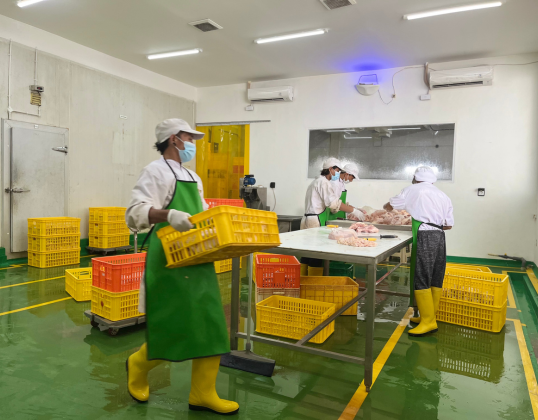
Traditional chicken slaughtering in local markets often faces challenges in hygiene, distribution delays, and inconsistent quality.
Meanwhile, modern Chicken Slaughterhouse offer significant advantages:
- Guaranteed quality: Products meet both halal and health standards.
- High productivity: Thousands of chickens can be processed daily without sacrificing quality.
- Cost efficiency: Integrated processes lower overall operational costs.
- Eco-friendly: Waste treatment prevents environmental pollution.
- Food safety: Reduces the risk of zoonotic diseases transmitted from animals to humans.
This is why many restaurants, hotels, and supermarkets prefer suppliers that collaborate with modern slaughterhouses.
Impact of Chicken Slaughterhouse on the Culinary Industry
The culinary industry benefits directly from modern chicken processing facilities. A steady supply of hygienic, fresh chicken allows businesses to maintain menu consistency and customer satisfaction.
In addition, stable supply from slaughterhouses helps control chicken prices in the market. Considering chicken is a staple protein source that directly affects food inflation, the role of Chicken Slaughterhouses becomes crucial in maintaining price stability.
International Standards in Chicken Slaughterhouse
To compete globally, slaughterhouses must comply with international standards such as Good Manufacturing Practices (GMP) and Hazard Analysis and Critical Control Points (HACCP).
These standards cover:
- Hygienic processing from start to finish.
- Proper post-slaughter handling.
- Strict quality control checkpoints.
- Documentation of every production stage.
By applying these standards, a Chicken Slaughterhouse can serve not only domestic demand but also open opportunities for exports.
Challenges Faced by Chicken Slaughterhouses in Indonesia
Despite rapid growth, several challenges remain for the industry:
- Lack of skilled workforce to operate modern machines.
- Infrastructure limitations in rural areas that disrupt distribution.
- High investment costs for modern technology.
- Consumer habits that still prefer traditional slaughter methods.
However, with government support and increasing market demand for hygienic products, these challenges are gradually being overcome.
The Role of Distributors in Supporting Chicken Slaughterhouses
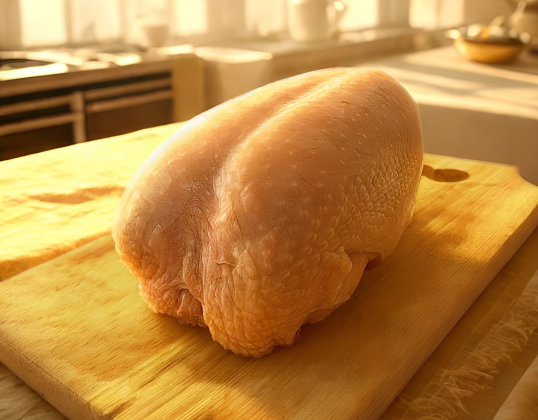
Even the best slaughterhouse needs reliable distribution channels. Distributors act as the bridge between slaughterhouses and end consumers such as restaurants, hotels, modern markets, and traditional vendors.
A professional distributor ensures:
- Large and small scale supply availability.
- Product freshness during delivery.
- Competitive prices in the market.
- Fast and reliable delivery service.
Without distributors, it would be difficult for Chicken Slaughterhouses to ensure their products reach consumers in top condition.
Happy Cix: Chicken Distributor in Bali
Among many distributors, Happy Cix stands out as one of the most trusted partners in distributing poultry products from modern slaughterhouses. As a leading Chicken Distributor in Bali, Happy Cix guarantees that every product delivered is fresh, halal-certified, and hygienic.
Happy Cix operates with a wide distribution network, refrigerated storage, and a reliable delivery fleet. Beyond infrastructure, the company is also committed to providing competitive prices without compromising on quality.
For culinary businesses and households in Bali, Happy Cix is a trusted solution to meet the daily demand for safe and high-quality chicken. It is not an exaggeration to say that Happy Cix is among the most reliable poultry distributors in Indonesia.
Conclusion
The transformation toward modern Chicken Slaughterhouses is a vital step for a more efficient, hygienic, and competitive poultry industry. Technological innovations make production faster, more environmentally friendly, and capable of meeting international food safety standards.
Yet, slaughterhouses cannot stand alone without efficient distribution channels. This is where distributors play a critical role in connecting production with consumers.
One prominent example is Happy Cix, which ensures fresh, halal, and high-quality poultry supply in Bali. With support from modern slaughterhouses and professional distribution systems, the future of Indonesia’s poultry industry is set to thrive.
Healthy Chicken Breast Fillet Recipe Inspirations
In the world of healthy cooking, chicken breast fillet is one of the most popular ingredients. Its tender texture, low fat content, and high protein make it the perfect choice for a nutritious daily menu. Not only is it favored by those on a diet, but it is also popular among fitness enthusiasts because it helps build muscle and speeds up recovery. Another advantage is that chicken breast is easy to turn into a variety of delicious dishes without reducing its nutritional value.
This article will explore various healthy chicken breast fillet ideas—from selecting the best ingredients and proper cooking tips to creative menu recommendations suitable for different nutritional needs.
Why Choose Chicken Breast Fillet?
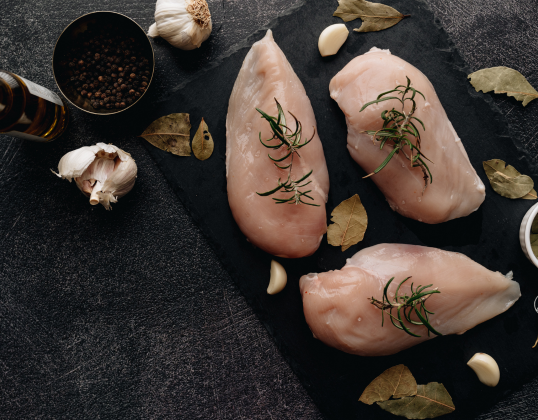
There are many reasons why chicken breast fillet is a favorite. First, it contains less fat compared to the thigh, making it suitable for those who want to maintain their weight. Second, it has a high protein content, which helps repair body tissues and build muscle mass.
In addition, chicken breast cooks relatively quickly, saving time in the kitchen. This practicality makes it a common choice as a staple ingredient at home. In modern cooking, chicken fillet is also widely used because it pairs well with a variety of seasonings, whether Asian or Western flavors.
Tips for Choosing Quality Chicken Breast Fillet
To ensure your healthy dishes are truly safe and tasty, it’s important to choose high-quality chicken breast. Here are the tips:
- Color – Choose fillets that are fresh pink, not pale or grayish. A pale color can indicate that the meat is no longer fresh.
- Texture – Touch the surface of the meat and make sure it feels firm and springy, not mushy. A mushy texture usually indicates poor quality.
- Aroma – Fresh chicken breast has a neutral or mildly natural scent. If there’s a strong or sour odor, it’s best to avoid it.
- Cleanliness – Make sure the packaging is tightly sealed and there is no excess liquid inside.
By paying attention to these points, the quality and safety of your chicken breast fillet will be better assured.
Cooking Techniques to Keep Chicken Breast Juicy
One challenge in cooking chicken breast fillet is preventing it from becoming dry. Overcooked chicken breast will lose moisture and turn tough. To avoid this, here are some techniques:
- Poaching – Simmering chicken in water or broth over low heat keeps it moist and results in a tender taste.
- Marination – Soaking the meat in seasonings for at least 30 minutes helps retain texture and flavor.
- Quick Roasting – Cooking at high heat for a short time keeps the inside juicy.
- Sous Vide – Cooking in a vacuum-sealed bag in low-temperature water delivers maximum tenderness.
Healthy Chicken Breast Fillet Dish Ideas
Here are some recommended chicken breast fillet recipes you can try at home:
- Lemon & Rosemary Grilled Chicken Breast Fillet
This recipe combines the freshness of lemon with the fragrant aroma of rosemary. Ingredients are simple: fresh chicken fillet, lemon juice, olive oil, salt & pepper, and fresh rosemary. Simply marinate the chicken for 1 hour, then grill until cooked. The result is tender chicken with a naturally fresh taste. - Chicken Breast Fillet Salad with Yogurt Dressing
Perfect for a low-calorie lunch, shredded poached chicken breast is combined with fresh vegetables like lettuce, cherry tomatoes, and cucumbers. Low-fat yogurt dressing adds creaminess without excessive fat. - Stir-Fried Chicken Breast with Teriyaki Sauce
Stir-fried chicken breast fillet with low-sugar teriyaki sauce is a great option for those who enjoy Asian flavors. To improve color and nutrients, add carrots, broccoli, and red bell peppers. - Clear Chicken Breast Fillet Soup with Ginger
This light soup with warming ginger is perfect for keeping the body warm. Slow simmering creates naturally savory broth without artificial flavor enhancers. - Oven-Baked Chicken Breast with Spices
A mix of spices like paprika powder, garlic, and black pepper creates a Western-style taste. Baking makes the surface slightly crispy while keeping the inside tender.
Benefits of Consuming Chicken Breast Fillet
Eating chicken breast fillet offers many health benefits, including:
- High-Quality Protein Source – Supports muscle growth and tissue repair.
- Low in Fat – Suitable for low-calorie diets.
- Boosts Metabolism – Protein helps the body burn more calories.
- Supports Heart Health – Low saturated fat is good for heart health.
Although chicken breast fillet is very healthy, it’s best consumed in balance with complex carbohydrates, vegetables, and healthy fats for more complete nutrition. For example, pair grilled chicken with brown rice and stir-fried vegetables, or serve a chicken salad with whole-grain bread. To ensure optimal meat quality, it’s recommended to purchase from a trusted source.
Recommended Chicken Breast Fillet Supplier in Bali
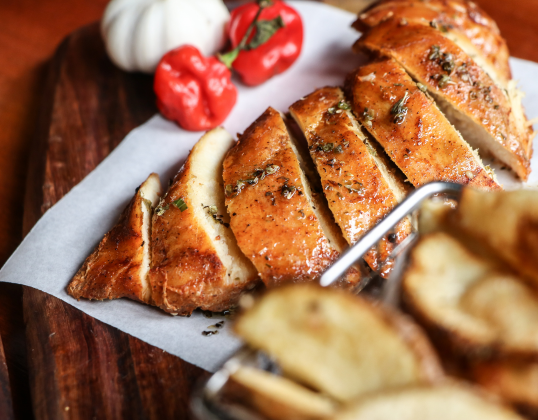
For those in Bali looking for quality chicken breast fillet, one of the best recommendations is Happy Cix from PT Tulus Ayu Pangan Lestari. This brand is known for prioritizing high standards of hygiene, quality, and freshness. The cutting process is done hygienically using a cold chain system to keep the fillet fresh until it reaches consumers.
Not only for household needs, Happy Cix is also the top choice for many hotels, restaurants, and catering services in Bali. Its strength lies in consistent quality. Every chicken breast fillet is processed from carefully selected chickens, raised with quality feed and free from harmful substances. The texture is tender, the color fresh, and the aroma naturally clean without an overpowering smell. This makes Happy Cix products ideal for a wide range of healthy dishes—from low-fat grilled menus to Asian-style stir-fries.
In addition, PT Tulus Ayu Pangan Lestari offers fast and punctual distribution across Bali. Consumers can order in small or large quantities as needed, with the guarantee that products will arrive fresh and ready to cook. With a reputation trusted by many culinary businesses, choosing Happy Cix as your chicken fillet supplier ensures not only taste quality but also supports a healthy lifestyle through safe and nutritious ingredients.
Conclusion
Chicken breast fillet is a highly versatile, nutritious ingredient perfect for a variety of healthy dishes. With the right cooking techniques and creative recipe variations, you can enjoy delicious meals without guilt. From lemon rosemary grilled chicken to fresh salads, these dishes can inspire you to create healthy meals every day.
Incorporating chicken breast fillet into your diet is not just about flavor—it’s a long-term investment in your health. By choosing quality ingredients, preparing them wisely, and pairing them with other nutritious foods, you can create meals that satisfy the palate while keeping your body in good shape.



